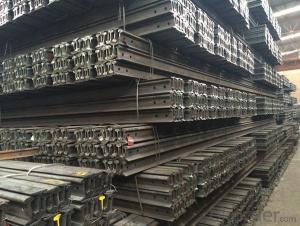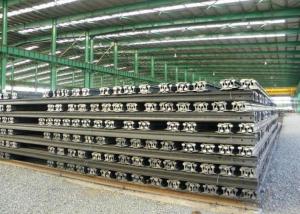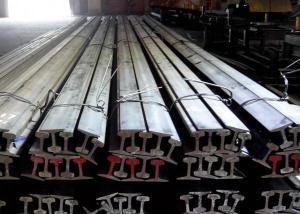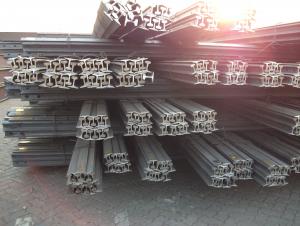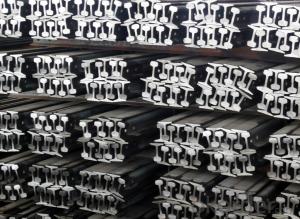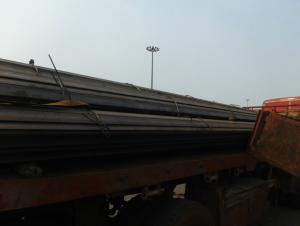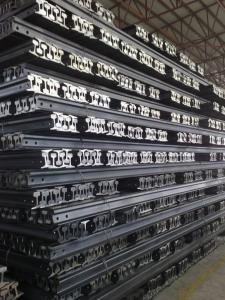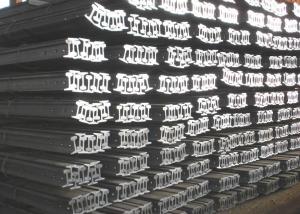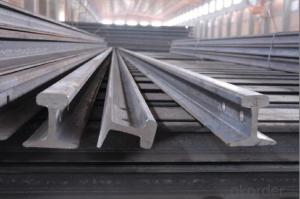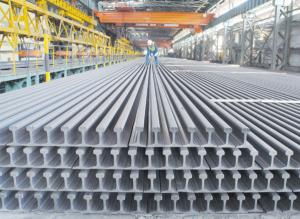High Quality Light Steel Rail for Structure Q235, 55Q
- Loading Port:
- Tianjin
- Payment Terms:
- TT or LC
- Min Order Qty:
- 25 m.t.
- Supply Capability:
- 200000 m.t./month
OKorder Service Pledge
OKorder Financial Service
You Might Also Like
Product Description:
OKorder is offering High Quality Light Steel Rail for Structure Q235, 55Q at great prices with worldwide shipping. Our supplier is a world-class manufacturer of steel, with our products utilized the world over. OKorder annually supplies products to European, North American and Asian markets. We provide quotations within 24 hours of receiving an inquiry and guarantee competitive prices.
Product Applications:
High Quality Light Steel Rail for Structure Q235, 55Q is mainly used in forest region, mines, factories and construction sites laid of the place such as temporary transport line and light motorcycles with line, for example: railway, subway, transportation track, express, curve way, tunnel way.
Product Advantages:
OKorder's High Quality Light Steel Rail for Structure Q235, 55Q are durable, strong, and resist corrosion.
Main Product Features:
· Premium quality
· Prompt delivery & seaworthy packing (30 days after receiving deposit)
· Corrosion resistance
· Can be recycled and reused
· Mill test certification
· Professional Service
· Competitive pricing
Product Description of High Quality Light Steel Rail for Structure Q235, 55Q:
Specifications of High Quality Light Steel Rail for Structure Q235, 55Q
Production Standard: GB11264-89
Material: Q235, 55Q
Grade | Element(%) | ||||
C | Mn | S
| P
| Si
| |
Q235 |
0.12—0.20 |
0.3—0.7 |
≤0.045 |
≤0.045
|
≤0.3
|
55Q | 0.50—0.60 | 0.70—1.00 | ≤0.050 | ≤0.045 | 0.15-0.35 |
Sizes: 9kg, 12kg, 15kg, 22kg, 30kg
Length: 6M, 8M, 10M, 12M or as the requriement

Invoicing on theoretical weight or actual weight as customer request
Payment terms: 30% advance payment by T/T, 70% payment against the copy of the B/L; 100% L/C at sight, etc.
Package & Delivery of Ms Light Steel Rail Q235, 55Q
1. Package: it is nude packed in bundles by steel wire rod
2. Bundle weight: not more than 3.5MT for bulk vessel; less than 3 MT for container load

3. Marks:
Color marking: There will be color marking on both end of the bundle for the cargo delivered by bulk vessel. That makes it easily to distinguish at the destination port.
Tag mark: there will be tag mark tied up on the bundles. The information usually including supplier logo and name, product name, made in China, shipping marks and other information request by the customer.
If loading by container the marking is not needed, but we will prepare it as customer request.
4. Transportation: the goods are delivered by truck from mill to loading port, the maximum quantity can be loaded is around 40MTs by each truck. If the order quantity cannot reach the full truck loaded, the transportation cost per ton will be little higher than full load.
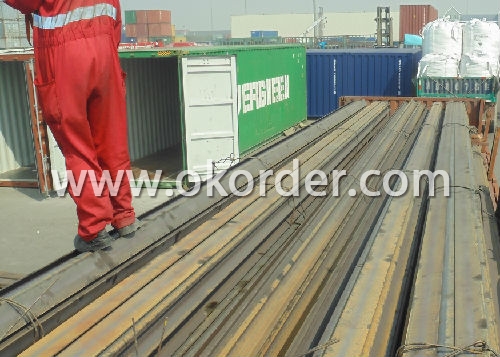
5. Delivered by container or bulk vessel
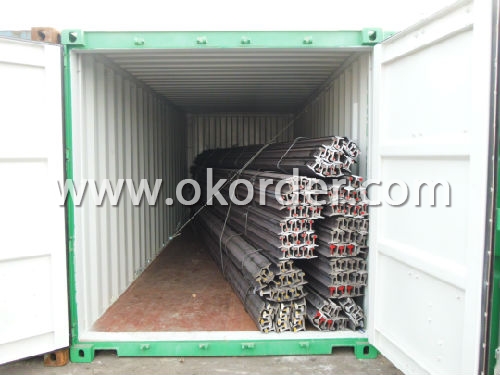
6. Delivery Time: All the High Quality Light Steel Rail for Structure Q235, 55Q will be transpoted at the port of Tianjin, China within 30 days after receiving the advance payment by T/T or the orginal L/C at sight.
Production flow of Ms Light Steel Rail Q235, 55Q
Material prepare (billet) —heat up—rough rolling—precision rolling—cooling—packing—storage and transportation
Inspection of Ms Light Steel Rail Q235, 55Q
We will send the MTC of the factory to the clients directly which contains the anlisis of the heat, chemiqual composition, phisical characteristicas, etc.
FAQ:
Q1: What is the normal tolerance of High Quality Light Steel Rail for Structure Q235, 55Q?
A1: Normally 3%-5%, but we can also produce the goods according to the customers' requests.
Q2: Can fit in the containers of 20fts the steel beams of High Quality Light Steel Rail for Structure Q235, 55Q?
A2: No proble, we can put them into the containers in the form sideling.
Q3: The products are invoicing on theoritical weight or on actual weight?
A3: We can do it in both manners, according to the customers' request.
- Q:How do steel rails contribute to train speed maintenance?
- Steel rails contribute to train speed maintenance in several ways. Firstly, steel rails provide a smooth and stable surface for the train wheels to roll on. This reduces friction and allows the train to maintain a consistent speed. The low friction also helps in reducing wear and tear on the train wheels and tracks, resulting in less maintenance and longer lifespan. Secondly, steel rails are strong and durable, capable of withstanding heavy loads and constant use. This allows trains to travel at high speeds without the risk of derailment or track damage. The stability and integrity of the steel rails ensure that the train remains on track, maintaining its speed and preventing any accidents. Furthermore, steel rails are designed to be straight and level, which assists in maintaining train speed. The absence of curves or uneven surfaces reduces the need for the train to slow down or adjust its speed, resulting in efficient and consistent travel. In addition, steel rails are carefully engineered to provide proper alignment and gauge. The correct alignment ensures that the train remains on track and minimizes any lateral movements that could affect speed. The gauge, which is the distance between the rails, is also crucial in maintaining train speed. A consistent gauge prevents any lateral movement of the train wheels and ensures a smooth and stable ride. Overall, steel rails play a vital role in maintaining train speed. They provide a smooth surface, strength, stability, and proper alignment, all of which contribute to efficient and safe train travel at high speeds.
- Q:Can steel rails be used in curved elevated railway structures?
- Yes, steel rails can be used in curved elevated railway structures. Steel is a versatile and durable material that is commonly used in railway construction due to its strength and resistance to wear and tear. It can easily be shaped and bent to accommodate curves in elevated railway structures, allowing for efficient and safe train operations. Additionally, steel rails provide stability and support to the railway system, ensuring the smooth movement of trains around curves. However, it is important to design and engineer the curved elevated railway structure properly to ensure that the steel rails can handle the forces and stresses associated with the curvature.
- Q:How are steel rails inspected for wear and tear in high-traffic areas?
- Steel rails in high-traffic areas are inspected for wear and tear through a combination of visual inspections, ultrasonic testing, and track geometry measurements. Visual inspections involve trained professionals examining the rails for any visible signs of damage, such as cracks, breaks, or excessive wear. Ultrasonic testing is also utilized, where specialized equipment is used to detect internal flaws or defects in the rails, even those not visible to the naked eye. Additionally, track geometry measurements are taken to ensure the rails are properly aligned, and any deviations from the desired specifications are identified. These comprehensive inspection methods help ensure the safety and reliability of steel rails in high-traffic areas.
- Q:Are steel rails suitable for light rail transit systems?
- Steel rails are ideal for light rail transit systems. They have been widely used in various railway systems, including light rail transit, for many years. Their durability, strength, and ability to handle heavy loads and constant use are well-known. Steel rails offer a stable and reliable track structure that can support the weight of light rail trains and provide a comfortable ride for passengers. Moreover, steel rails have excellent resistance to wear and tear, making them suitable for high-traffic areas and reducing track maintenance needs. The smooth surface of steel rails also reduces friction, enabling trains to operate efficiently at higher speeds. Another advantage of steel rails is their compatibility with different rail fastening systems, making installation and maintenance easy. This flexibility allows for efficient track adjustments and repairs, ensuring the overall safety and reliability of the light rail transit system. Additionally, steel rails can withstand various weather conditions, including extreme temperatures, heavy rain, and snow, without significant deterioration. This makes them suitable for light rail systems operating in different climates and environments. In conclusion, steel rails are a suitable choice for light rail transit systems due to their durability, strength, resistance to wear and tear, compatibility with rail fastening systems, and ability to withstand different weather conditions. They provide a stable and reliable track structure, ensuring a smooth and comfortable ride for passengers while minimizing maintenance requirements.
- Q:What are the benefits of using steel rails over other materials?
- There are several benefits of using steel rails over other materials in various applications. Firstly, steel rails are exceptionally durable and have a long lifespan. Steel is a strong and robust material, capable of withstanding heavy loads, extreme weather conditions, and constant wear and tear. This durability ensures that steel rails require less maintenance and replacement compared to other materials, resulting in cost savings over the long term. Secondly, steel rails provide excellent safety and stability. The strength of steel allows for the construction of sturdy and secure rail tracks, which are crucial for ensuring the safety of trains and passengers. Steel rails also offer superior resistance to deformation and buckling under heavy loads, reducing the risk of accidents or derailments. Moreover, steel rails have high conductivity, making them ideal for electrical systems such as railway signaling and electrification. Steel's electrical conductivity allows for efficient transmission of electrical signals and power, ensuring reliable and speedy communication between trains and control centers. Additionally, steel rails offer versatility in terms of design and construction. They can be easily shaped and formed into various profiles and lengths, allowing for customization based on specific requirements. Steel rails can also be easily welded or joined, facilitating the construction of complex rail networks or modifications to existing tracks. Furthermore, steel is a sustainable and environmentally friendly material. It is fully recyclable, and the steel industry has made significant advancements in reducing its carbon footprint. By choosing steel rails, the transportation sector can contribute to a greener and more sustainable future. In conclusion, the benefits of using steel rails over other materials include durability, safety, conductivity, versatility, and sustainability. These advantages make steel rails a preferred choice in various applications, including railway systems, ensuring efficient, reliable, and safe transportation.
- Q:How do steel rails handle train acceleration and deceleration?
- Steel rails are designed to handle the forces of train acceleration and deceleration effectively. The high strength and durability of steel allow the rails to withstand the heavy loads and friction generated during these processes. The smooth and continuous surface of the steel rails ensures minimal resistance and enables efficient transfer of power between the train wheels and the tracks, allowing for smooth acceleration and deceleration. Additionally, steel rails are carefully maintained and inspected to ensure their structural integrity, which further contributes to their ability to handle these dynamic forces.
- Q:Can steel rails be used in automated guided vehicle systems?
- Yes, steel rails can be used in automated guided vehicle systems. Steel rails provide a stable and precise path for the automated guided vehicles to follow, ensuring accurate and efficient movement within a facility.
- Q:What are the safety guidelines for working on steel rails?
- The safety guidelines for working on steel rails include wearing appropriate personal protective equipment (PPE) such as safety boots, gloves, and high-visibility clothing. Workers should also be trained on proper handling and lifting techniques to avoid strain and injury. It is crucial to follow proper procedures for working in close proximity to moving trains, ensuring that workers are aware of their surroundings and maintaining a safe distance from the tracks. Regular inspections and maintenance of the rails should be conducted to identify any potential hazards or defects. Additionally, workers should be trained on emergency procedures and be aware of the appropriate response in case of an accident or incident.
- Q:What are the advantages of continuous welded steel rails?
- Continuous welded steel rails have several advantages. Firstly, they provide a smoother and more comfortable ride for trains, reducing vibrations and noise. This improves passenger comfort and overall safety. Secondly, the continuous welding eliminates the need for track joints, which reduces maintenance requirements and enhances the overall durability of the rail system. Additionally, the absence of joints decreases the risk of derailments and increases the speed at which trains can safely travel. Lastly, continuous welded steel rails offer better electrical conductivity, ensuring efficient power transmission for electric trains and reducing the risk of power loss. Overall, these advantages make continuous welded steel rails a preferred choice for modern rail systems.
- Q:What are the different types of rail maintenance vehicles used with steel rails?
- There are several different types of rail maintenance vehicles used with steel rails. These vehicles are designed to perform various tasks that are necessary for the upkeep and maintenance of railway tracks. Here are some of the most common types: 1. Ballast Regulator: This vehicle is used to distribute and shape the ballast, which is the crushed stone or gravel that supports the railway tracks. It helps to maintain the proper alignment and stability of the tracks. 2. Tamping Machine: Tamping machines are used to pack the ballast underneath the sleepers, ensuring a stable and even track bed. These vehicles use hydraulic or pneumatic systems to apply pressure on the ballast, effectively compacting it. 3. Rail Grinder: Rail grinders are used to remove any irregularities or defects on the surface of the tracks. These vehicles consist of grinding stones or rotating discs that smooth out the rail surface, improving ride quality and reducing noise. 4. Rail Welding Machine: Rail welding machines are used to join two sections of rail together. These machines use electric or thermite welding techniques to create a strong and seamless connection between the rails. 5. Track Geometry Measurement Vehicle: These vehicles are equipped with specialized sensors and measuring equipment to assess the condition of the tracks. They collect data on parameters such as track alignment, gauge, and elevation, which helps identify any issues that need to be addressed. 6. Rail Inspection Vehicle: Rail inspection vehicles are used to visually inspect the tracks for any signs of damage or wear. These vehicles are equipped with cameras and sensors to detect defects such as cracks, corrosion, or loose fastenings. 7. Rail Cleaning Vehicle: These vehicles are used to remove debris, vegetation, and other foreign objects from the tracks. They help maintain a clean and obstruction-free railway environment, which is essential for safe and efficient train operations. These are just a few examples of the different types of rail maintenance vehicles used with steel rails. Each vehicle plays a vital role in ensuring the safety, reliability, and longevity of railway tracks, contributing to smooth and uninterrupted train services.
1. Manufacturer Overview |
|
|---|---|
| Location | |
| Year Established | |
| Annual Output Value | |
| Main Markets | |
| Company Certifications | |
2. Manufacturer Certificates |
|
|---|---|
| a) Certification Name | |
| Range | |
| Reference | |
| Validity Period | |
3. Manufacturer Capability |
|
|---|---|
| a)Trade Capacity | |
| Nearest Port | |
| Export Percentage | |
| No.of Employees in Trade Department | |
| Language Spoken: | |
| b)Factory Information | |
| Factory Size: | |
| No. of Production Lines | |
| Contract Manufacturing | |
| Product Price Range | |
Send your message to us
High Quality Light Steel Rail for Structure Q235, 55Q
- Loading Port:
- Tianjin
- Payment Terms:
- TT or LC
- Min Order Qty:
- 25 m.t.
- Supply Capability:
- 200000 m.t./month
OKorder Service Pledge
OKorder Financial Service
Similar products
New products
Hot products
Related keywords
